Healthcare: Creative Inquiry Activities Question Answer 2022
VerifiedAdded on 2022/09/25
|19
|3390
|18
AI Summary
Contribute Materials
Your contribution can guide someone’s learning journey. Share your
documents today.
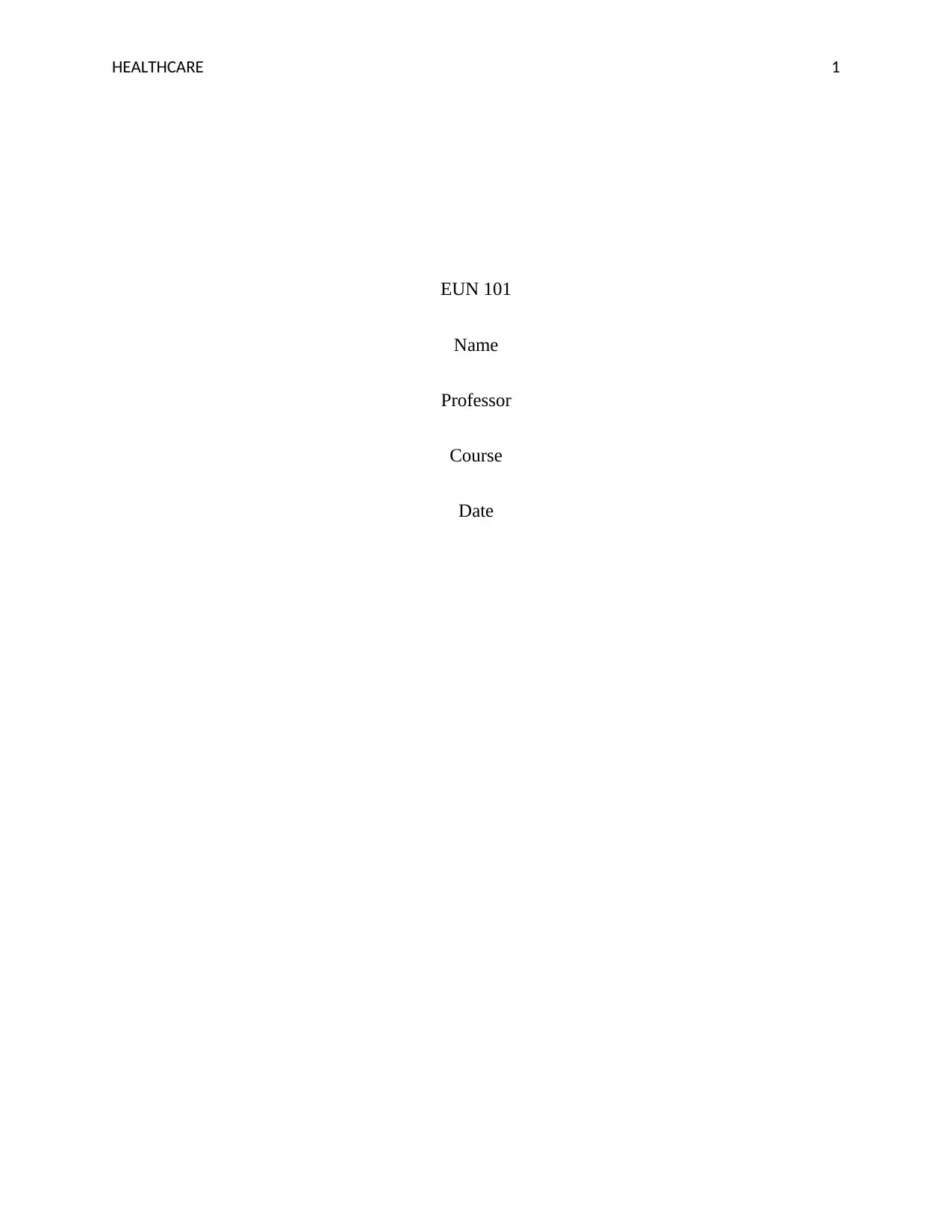
HEALTHCARE 1
EUN 101
Name
Professor
Course
Date
EUN 101
Name
Professor
Course
Date
Secure Best Marks with AI Grader
Need help grading? Try our AI Grader for instant feedback on your assignments.
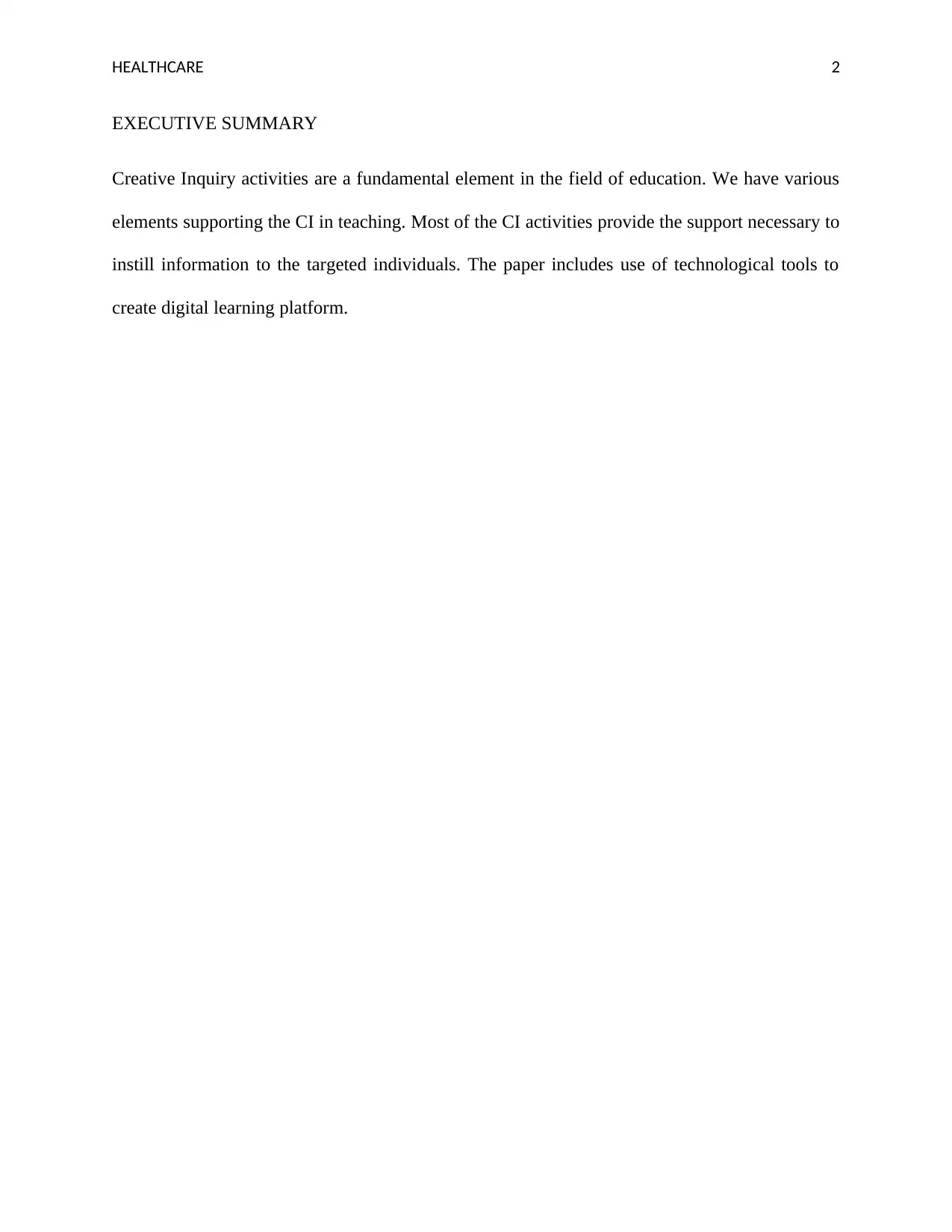
HEALTHCARE 2
EXECUTIVE SUMMARY
Creative Inquiry activities are a fundamental element in the field of education. We have various
elements supporting the CI in teaching. Most of the CI activities provide the support necessary to
instill information to the targeted individuals. The paper includes use of technological tools to
create digital learning platform.
EXECUTIVE SUMMARY
Creative Inquiry activities are a fundamental element in the field of education. We have various
elements supporting the CI in teaching. Most of the CI activities provide the support necessary to
instill information to the targeted individuals. The paper includes use of technological tools to
create digital learning platform.
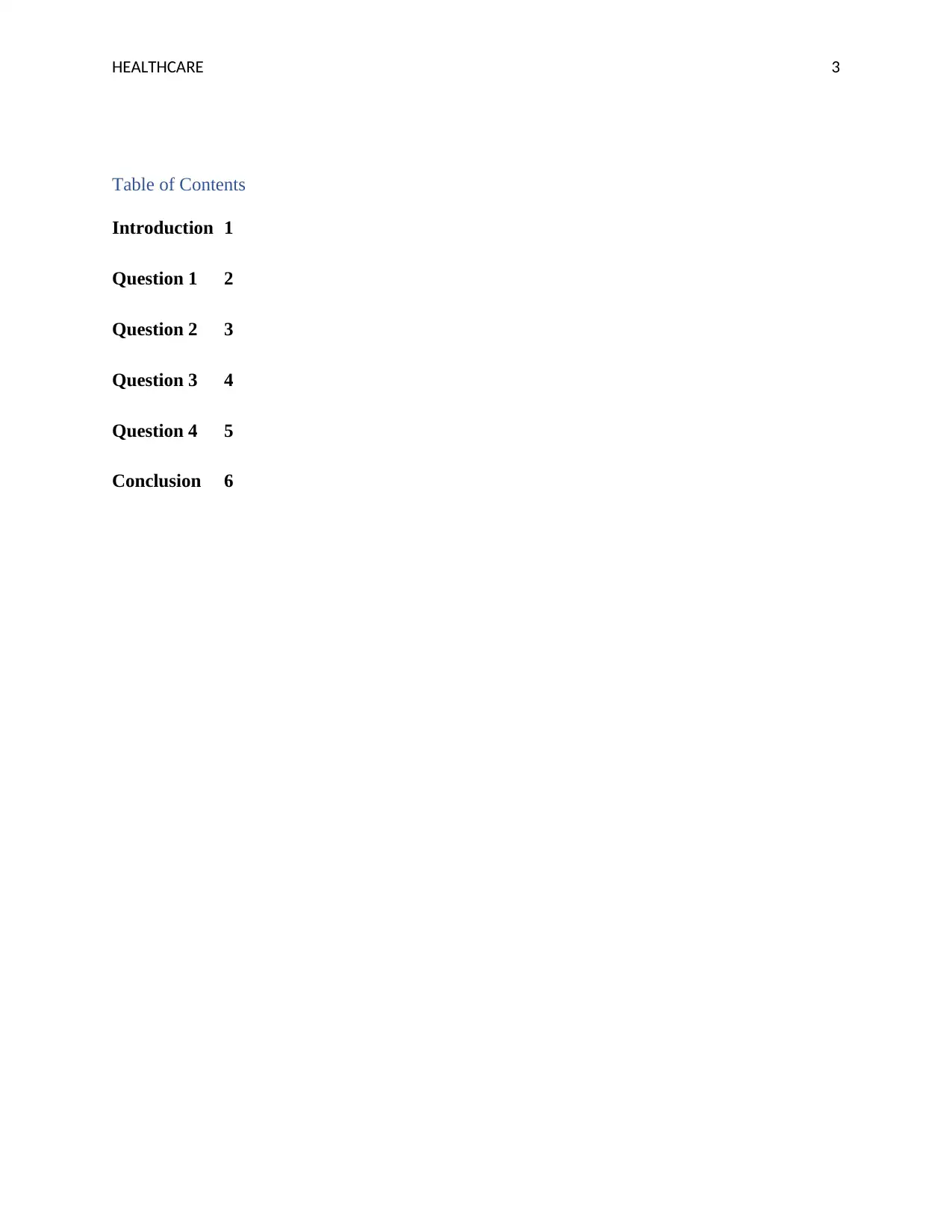
HEALTHCARE 3
Table of Contents
Introduction 1
Question 1 2
Question 2 3
Question 3 4
Question 4 5
Conclusion 6
Table of Contents
Introduction 1
Question 1 2
Question 2 3
Question 3 4
Question 4 5
Conclusion 6
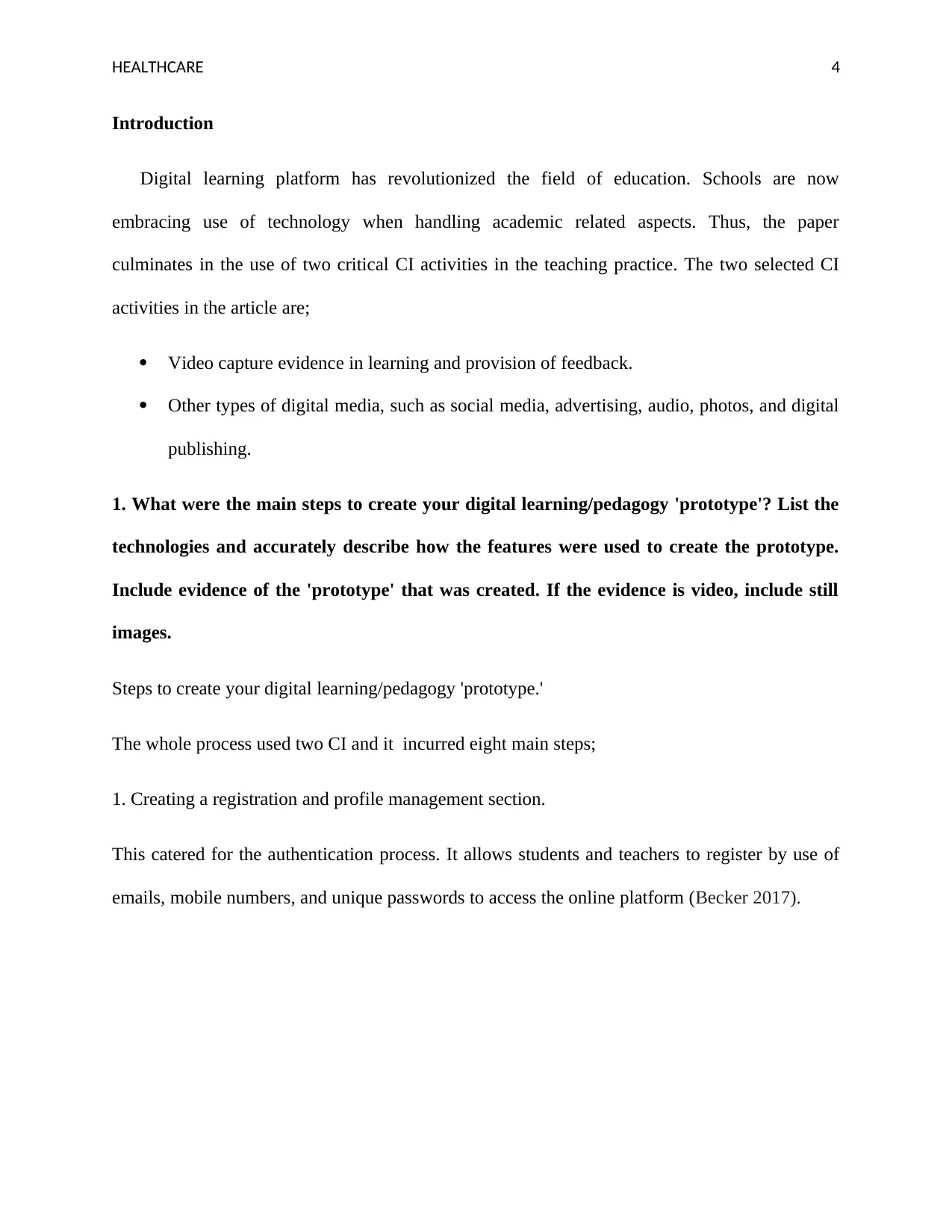
HEALTHCARE 4
Introduction
Digital learning platform has revolutionized the field of education. Schools are now
embracing use of technology when handling academic related aspects. Thus, the paper
culminates in the use of two critical CI activities in the teaching practice. The two selected CI
activities in the article are;
Video capture evidence in learning and provision of feedback.
Other types of digital media, such as social media, advertising, audio, photos, and digital
publishing.
1. What were the main steps to create your digital learning/pedagogy 'prototype'? List the
technologies and accurately describe how the features were used to create the prototype.
Include evidence of the 'prototype' that was created. If the evidence is video, include still
images.
Steps to create your digital learning/pedagogy 'prototype.'
The whole process used two CI and it incurred eight main steps;
1. Creating a registration and profile management section.
This catered for the authentication process. It allows students and teachers to register by use of
emails, mobile numbers, and unique passwords to access the online platform (Becker 2017).
Introduction
Digital learning platform has revolutionized the field of education. Schools are now
embracing use of technology when handling academic related aspects. Thus, the paper
culminates in the use of two critical CI activities in the teaching practice. The two selected CI
activities in the article are;
Video capture evidence in learning and provision of feedback.
Other types of digital media, such as social media, advertising, audio, photos, and digital
publishing.
1. What were the main steps to create your digital learning/pedagogy 'prototype'? List the
technologies and accurately describe how the features were used to create the prototype.
Include evidence of the 'prototype' that was created. If the evidence is video, include still
images.
Steps to create your digital learning/pedagogy 'prototype.'
The whole process used two CI and it incurred eight main steps;
1. Creating a registration and profile management section.
This catered for the authentication process. It allows students and teachers to register by use of
emails, mobile numbers, and unique passwords to access the online platform (Becker 2017).
Secure Best Marks with AI Grader
Need help grading? Try our AI Grader for instant feedback on your assignments.
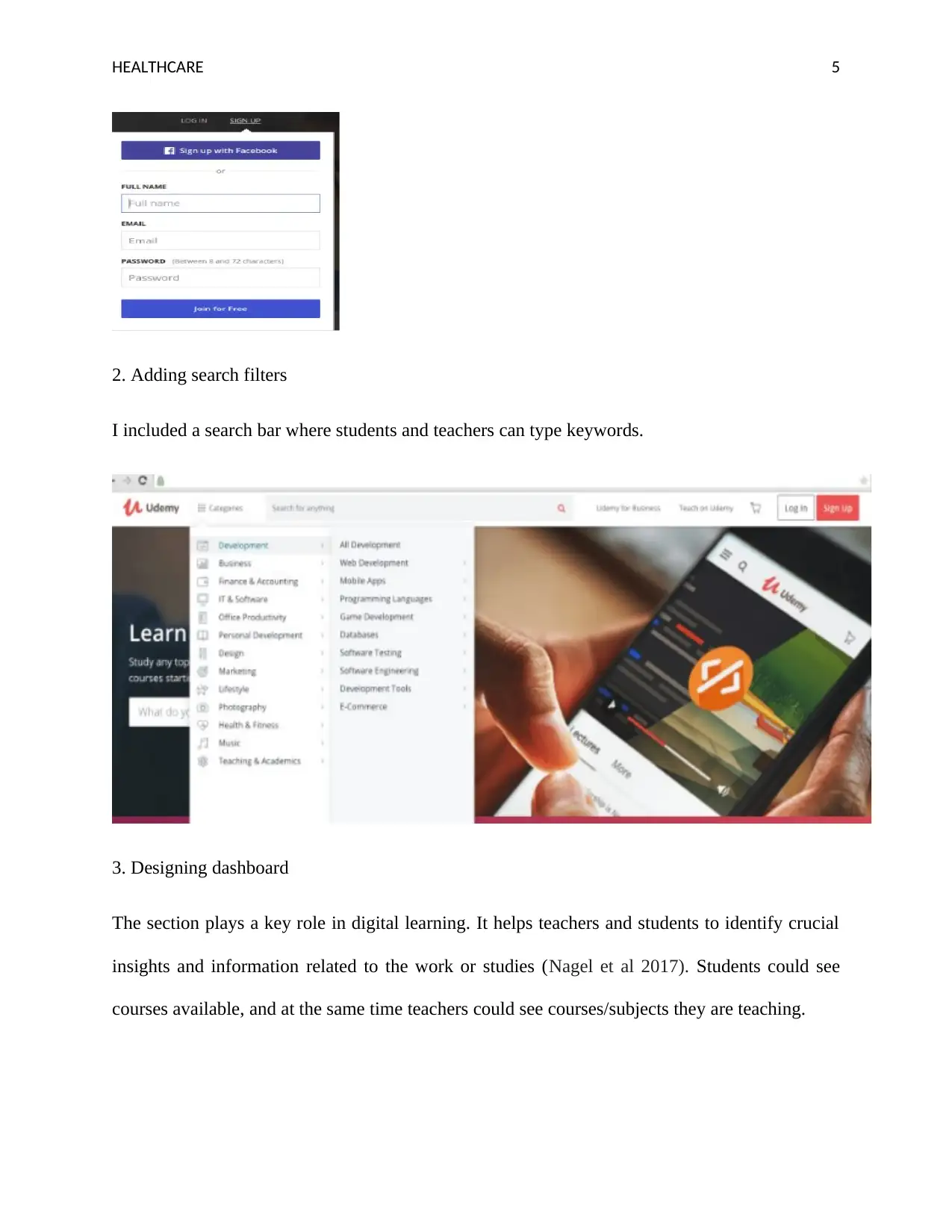
HEALTHCARE 5
2. Adding search filters
I included a search bar where students and teachers can type keywords.
3. Designing dashboard
The section plays a key role in digital learning. It helps teachers and students to identify crucial
insights and information related to the work or studies (Nagel et al 2017). Students could see
courses available, and at the same time teachers could see courses/subjects they are teaching.
2. Adding search filters
I included a search bar where students and teachers can type keywords.
3. Designing dashboard
The section plays a key role in digital learning. It helps teachers and students to identify crucial
insights and information related to the work or studies (Nagel et al 2017). Students could see
courses available, and at the same time teachers could see courses/subjects they are teaching.

HEALTHCARE 6
4. Adding course/subject page
The area where I employed most of the CI activities. It included videos, recordings, eBooks, and
chats. I also added a review section.
5. Creating a payment method page.
4. Adding course/subject page
The area where I employed most of the CI activities. It included videos, recordings, eBooks, and
chats. I also added a review section.
5. Creating a payment method page.
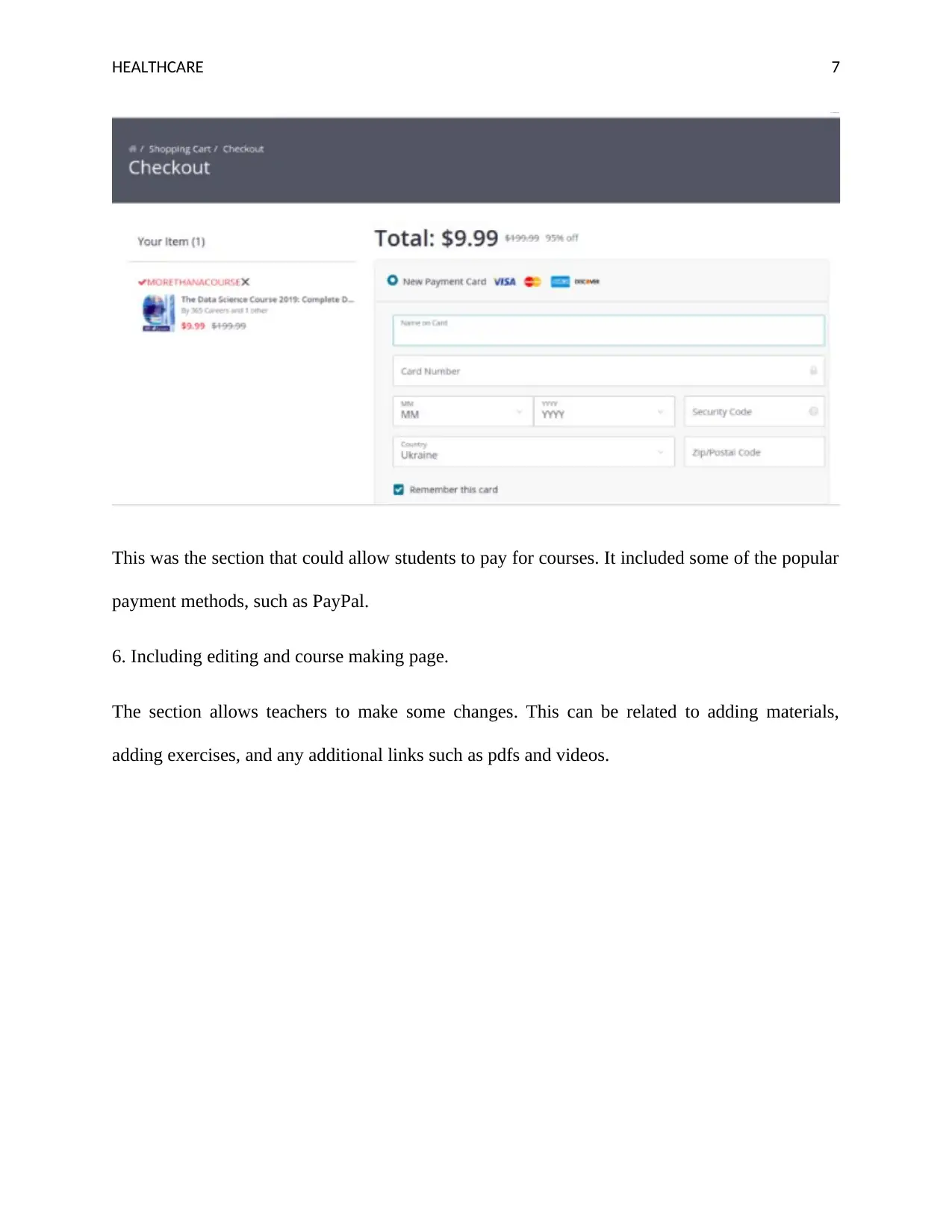
HEALTHCARE 7
This was the section that could allow students to pay for courses. It included some of the popular
payment methods, such as PayPal.
6. Including editing and course making page.
The section allows teachers to make some changes. This can be related to adding materials,
adding exercises, and any additional links such as pdfs and videos.
This was the section that could allow students to pay for courses. It included some of the popular
payment methods, such as PayPal.
6. Including editing and course making page.
The section allows teachers to make some changes. This can be related to adding materials,
adding exercises, and any additional links such as pdfs and videos.
Paraphrase This Document
Need a fresh take? Get an instant paraphrase of this document with our AI Paraphraser
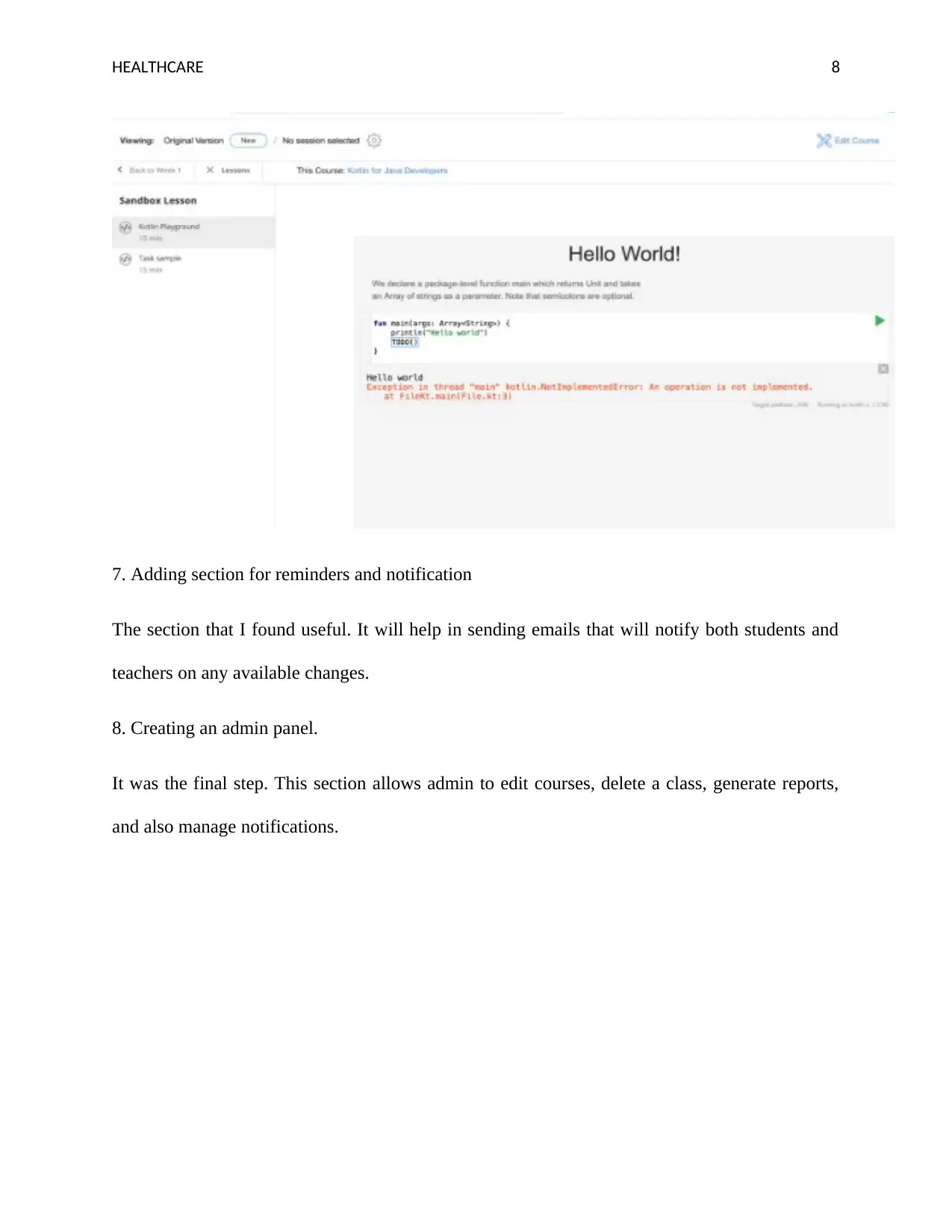
HEALTHCARE 8
7. Adding section for reminders and notification
The section that I found useful. It will help in sending emails that will notify both students and
teachers on any available changes.
8. Creating an admin panel.
It was the final step. This section allows admin to edit courses, delete a class, generate reports,
and also manage notifications.
7. Adding section for reminders and notification
The section that I found useful. It will help in sending emails that will notify both students and
teachers on any available changes.
8. Creating an admin panel.
It was the final step. This section allows admin to edit courses, delete a class, generate reports,
and also manage notifications.
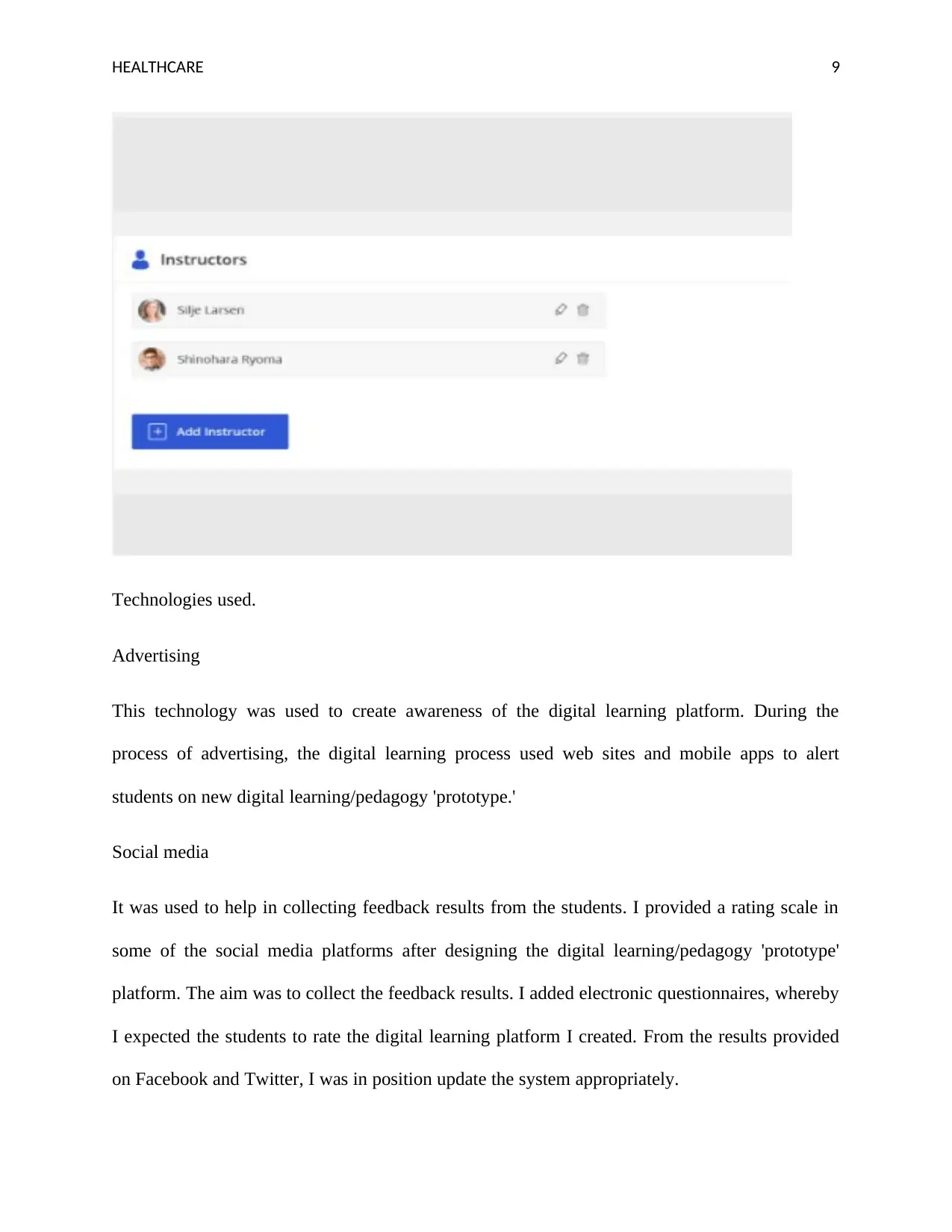
HEALTHCARE 9
Technologies used.
Advertising
This technology was used to create awareness of the digital learning platform. During the
process of advertising, the digital learning process used web sites and mobile apps to alert
students on new digital learning/pedagogy 'prototype.'
Social media
It was used to help in collecting feedback results from the students. I provided a rating scale in
some of the social media platforms after designing the digital learning/pedagogy 'prototype'
platform. The aim was to collect the feedback results. I added electronic questionnaires, whereby
I expected the students to rate the digital learning platform I created. From the results provided
on Facebook and Twitter, I was in position update the system appropriately.
Technologies used.
Advertising
This technology was used to create awareness of the digital learning platform. During the
process of advertising, the digital learning process used web sites and mobile apps to alert
students on new digital learning/pedagogy 'prototype.'
Social media
It was used to help in collecting feedback results from the students. I provided a rating scale in
some of the social media platforms after designing the digital learning/pedagogy 'prototype'
platform. The aim was to collect the feedback results. I added electronic questionnaires, whereby
I expected the students to rate the digital learning platform I created. From the results provided
on Facebook and Twitter, I was in position update the system appropriately.
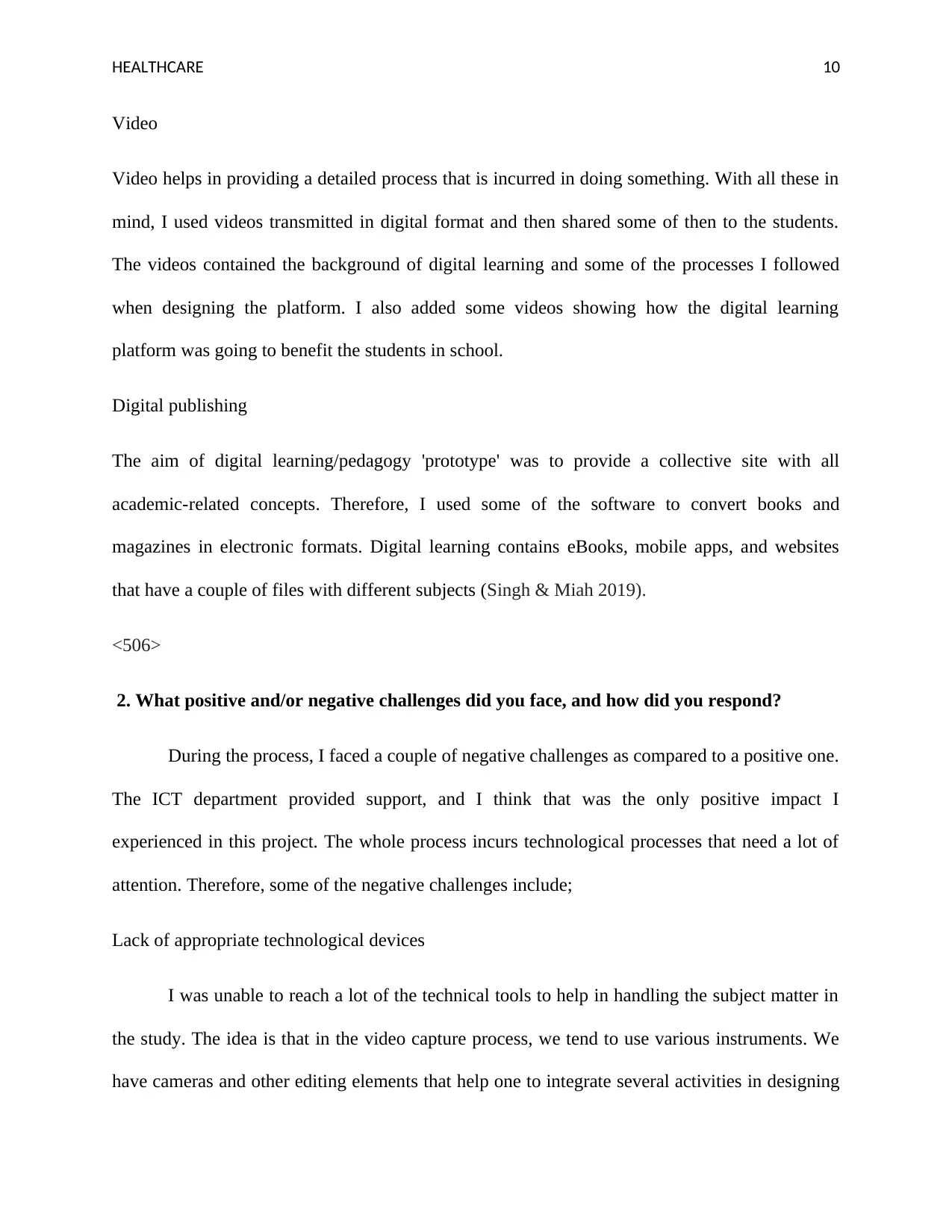
HEALTHCARE 10
Video
Video helps in providing a detailed process that is incurred in doing something. With all these in
mind, I used videos transmitted in digital format and then shared some of then to the students.
The videos contained the background of digital learning and some of the processes I followed
when designing the platform. I also added some videos showing how the digital learning
platform was going to benefit the students in school.
Digital publishing
The aim of digital learning/pedagogy 'prototype' was to provide a collective site with all
academic-related concepts. Therefore, I used some of the software to convert books and
magazines in electronic formats. Digital learning contains eBooks, mobile apps, and websites
that have a couple of files with different subjects (Singh & Miah 2019).
<506>
2. What positive and/or negative challenges did you face, and how did you respond?
During the process, I faced a couple of negative challenges as compared to a positive one.
The ICT department provided support, and I think that was the only positive impact I
experienced in this project. The whole process incurs technological processes that need a lot of
attention. Therefore, some of the negative challenges include;
Lack of appropriate technological devices
I was unable to reach a lot of the technical tools to help in handling the subject matter in
the study. The idea is that in the video capture process, we tend to use various instruments. We
have cameras and other editing elements that help one to integrate several activities in designing
Video
Video helps in providing a detailed process that is incurred in doing something. With all these in
mind, I used videos transmitted in digital format and then shared some of then to the students.
The videos contained the background of digital learning and some of the processes I followed
when designing the platform. I also added some videos showing how the digital learning
platform was going to benefit the students in school.
Digital publishing
The aim of digital learning/pedagogy 'prototype' was to provide a collective site with all
academic-related concepts. Therefore, I used some of the software to convert books and
magazines in electronic formats. Digital learning contains eBooks, mobile apps, and websites
that have a couple of files with different subjects (Singh & Miah 2019).
<506>
2. What positive and/or negative challenges did you face, and how did you respond?
During the process, I faced a couple of negative challenges as compared to a positive one.
The ICT department provided support, and I think that was the only positive impact I
experienced in this project. The whole process incurs technological processes that need a lot of
attention. Therefore, some of the negative challenges include;
Lack of appropriate technological devices
I was unable to reach a lot of the technical tools to help in handling the subject matter in
the study. The idea is that in the video capture process, we tend to use various instruments. We
have cameras and other editing elements that help one to integrate several activities in designing
Secure Best Marks with AI Grader
Need help grading? Try our AI Grader for instant feedback on your assignments.
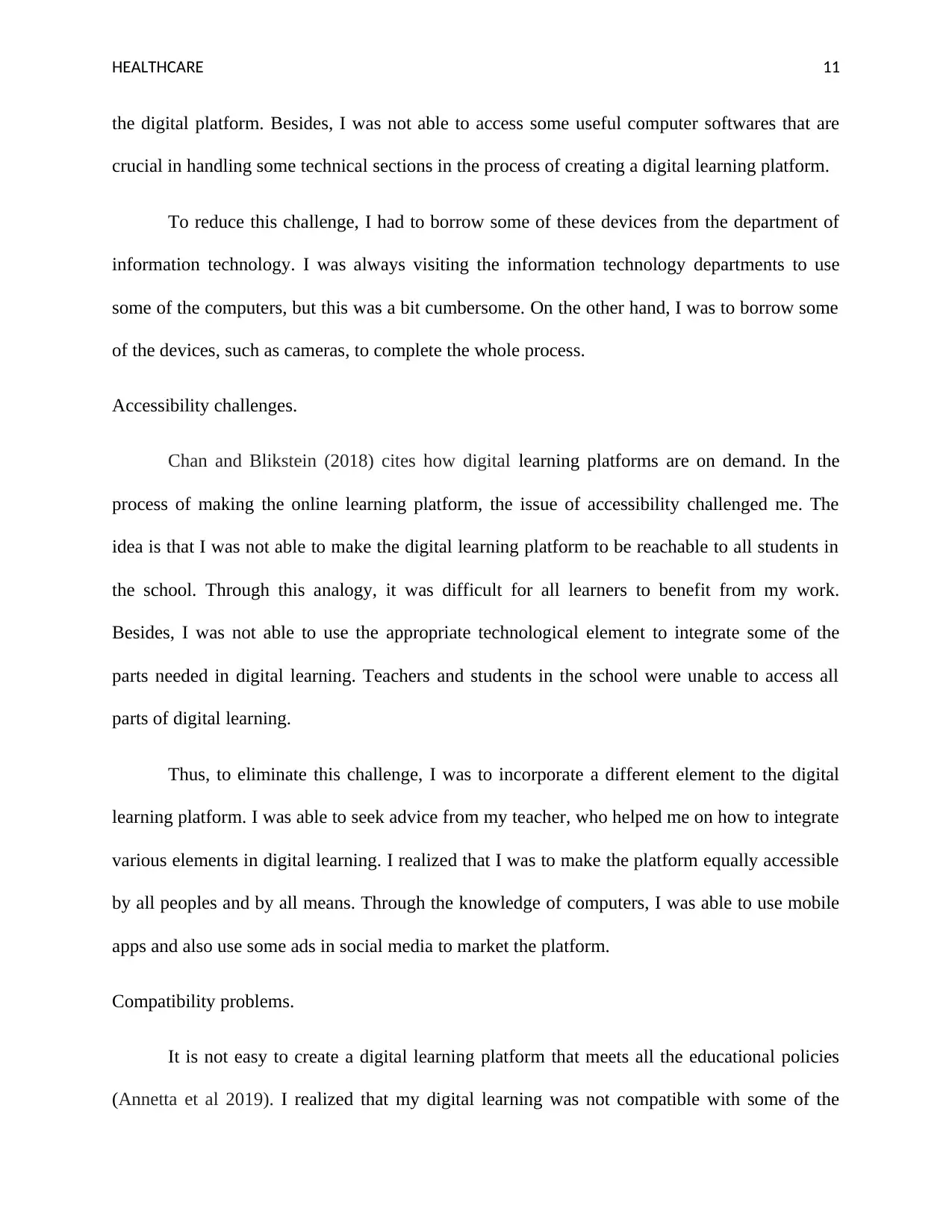
HEALTHCARE 11
the digital platform. Besides, I was not able to access some useful computer softwares that are
crucial in handling some technical sections in the process of creating a digital learning platform.
To reduce this challenge, I had to borrow some of these devices from the department of
information technology. I was always visiting the information technology departments to use
some of the computers, but this was a bit cumbersome. On the other hand, I was to borrow some
of the devices, such as cameras, to complete the whole process.
Accessibility challenges.
Chan and Blikstein (2018) cites how digital learning platforms are on demand. In the
process of making the online learning platform, the issue of accessibility challenged me. The
idea is that I was not able to make the digital learning platform to be reachable to all students in
the school. Through this analogy, it was difficult for all learners to benefit from my work.
Besides, I was not able to use the appropriate technological element to integrate some of the
parts needed in digital learning. Teachers and students in the school were unable to access all
parts of digital learning.
Thus, to eliminate this challenge, I was to incorporate a different element to the digital
learning platform. I was able to seek advice from my teacher, who helped me on how to integrate
various elements in digital learning. I realized that I was to make the platform equally accessible
by all peoples and by all means. Through the knowledge of computers, I was able to use mobile
apps and also use some ads in social media to market the platform.
Compatibility problems.
It is not easy to create a digital learning platform that meets all the educational policies
(Annetta et al 2019). I realized that my digital learning was not compatible with some of the
the digital platform. Besides, I was not able to access some useful computer softwares that are
crucial in handling some technical sections in the process of creating a digital learning platform.
To reduce this challenge, I had to borrow some of these devices from the department of
information technology. I was always visiting the information technology departments to use
some of the computers, but this was a bit cumbersome. On the other hand, I was to borrow some
of the devices, such as cameras, to complete the whole process.
Accessibility challenges.
Chan and Blikstein (2018) cites how digital learning platforms are on demand. In the
process of making the online learning platform, the issue of accessibility challenged me. The
idea is that I was not able to make the digital learning platform to be reachable to all students in
the school. Through this analogy, it was difficult for all learners to benefit from my work.
Besides, I was not able to use the appropriate technological element to integrate some of the
parts needed in digital learning. Teachers and students in the school were unable to access all
parts of digital learning.
Thus, to eliminate this challenge, I was to incorporate a different element to the digital
learning platform. I was able to seek advice from my teacher, who helped me on how to integrate
various elements in digital learning. I realized that I was to make the platform equally accessible
by all peoples and by all means. Through the knowledge of computers, I was able to use mobile
apps and also use some ads in social media to market the platform.
Compatibility problems.
It is not easy to create a digital learning platform that meets all the educational policies
(Annetta et al 2019). I realized that my digital learning was not compatible with some of the
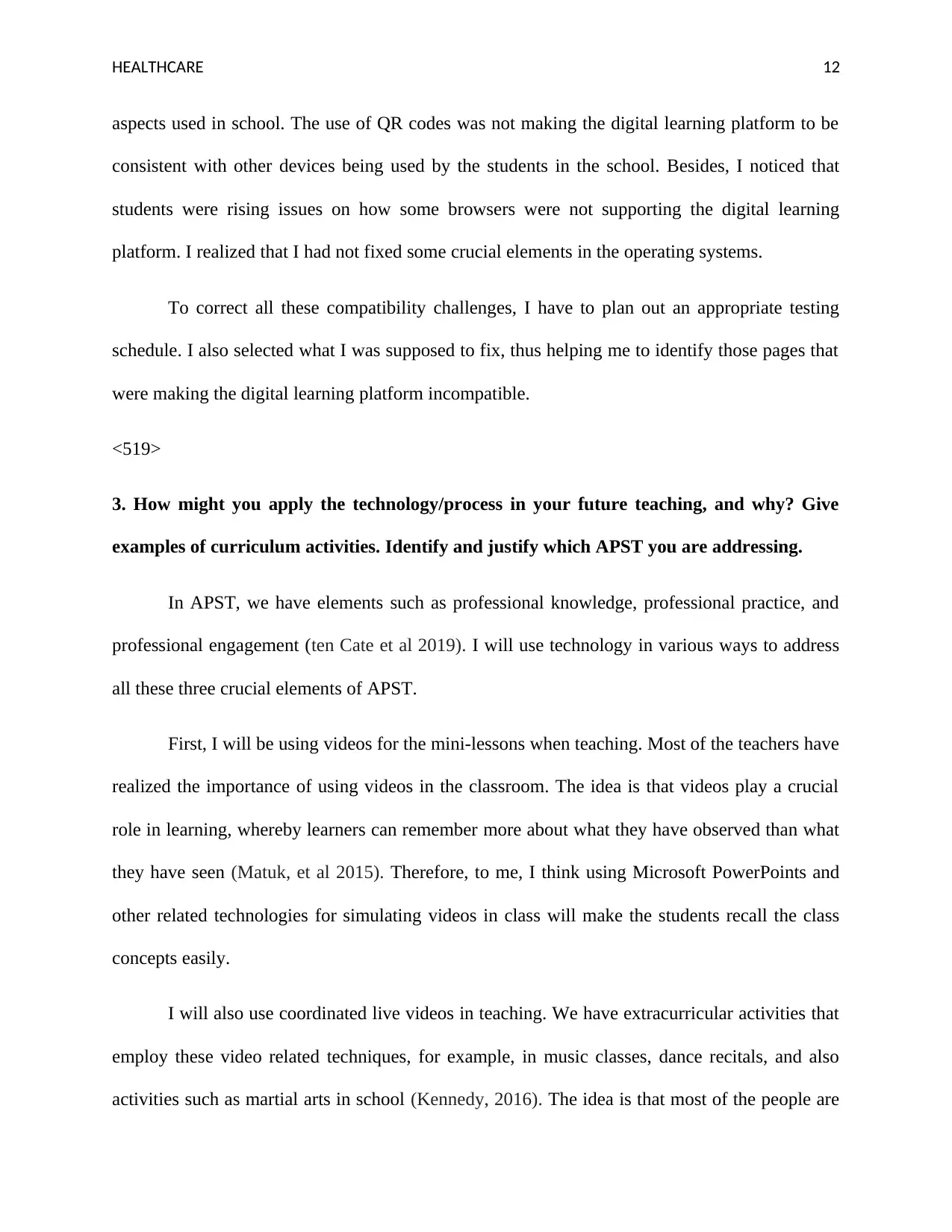
HEALTHCARE 12
aspects used in school. The use of QR codes was not making the digital learning platform to be
consistent with other devices being used by the students in the school. Besides, I noticed that
students were rising issues on how some browsers were not supporting the digital learning
platform. I realized that I had not fixed some crucial elements in the operating systems.
To correct all these compatibility challenges, I have to plan out an appropriate testing
schedule. I also selected what I was supposed to fix, thus helping me to identify those pages that
were making the digital learning platform incompatible.
<519>
3. How might you apply the technology/process in your future teaching, and why? Give
examples of curriculum activities. Identify and justify which APST you are addressing.
In APST, we have elements such as professional knowledge, professional practice, and
professional engagement (ten Cate et al 2019). I will use technology in various ways to address
all these three crucial elements of APST.
First, I will be using videos for the mini-lessons when teaching. Most of the teachers have
realized the importance of using videos in the classroom. The idea is that videos play a crucial
role in learning, whereby learners can remember more about what they have observed than what
they have seen (Matuk, et al 2015). Therefore, to me, I think using Microsoft PowerPoints and
other related technologies for simulating videos in class will make the students recall the class
concepts easily.
I will also use coordinated live videos in teaching. We have extracurricular activities that
employ these video related techniques, for example, in music classes, dance recitals, and also
activities such as martial arts in school (Kennedy, 2016). The idea is that most of the people are
aspects used in school. The use of QR codes was not making the digital learning platform to be
consistent with other devices being used by the students in the school. Besides, I noticed that
students were rising issues on how some browsers were not supporting the digital learning
platform. I realized that I had not fixed some crucial elements in the operating systems.
To correct all these compatibility challenges, I have to plan out an appropriate testing
schedule. I also selected what I was supposed to fix, thus helping me to identify those pages that
were making the digital learning platform incompatible.
<519>
3. How might you apply the technology/process in your future teaching, and why? Give
examples of curriculum activities. Identify and justify which APST you are addressing.
In APST, we have elements such as professional knowledge, professional practice, and
professional engagement (ten Cate et al 2019). I will use technology in various ways to address
all these three crucial elements of APST.
First, I will be using videos for the mini-lessons when teaching. Most of the teachers have
realized the importance of using videos in the classroom. The idea is that videos play a crucial
role in learning, whereby learners can remember more about what they have observed than what
they have seen (Matuk, et al 2015). Therefore, to me, I think using Microsoft PowerPoints and
other related technologies for simulating videos in class will make the students recall the class
concepts easily.
I will also use coordinated live videos in teaching. We have extracurricular activities that
employ these video related techniques, for example, in music classes, dance recitals, and also
activities such as martial arts in school (Kennedy, 2016). The idea is that most of the people are
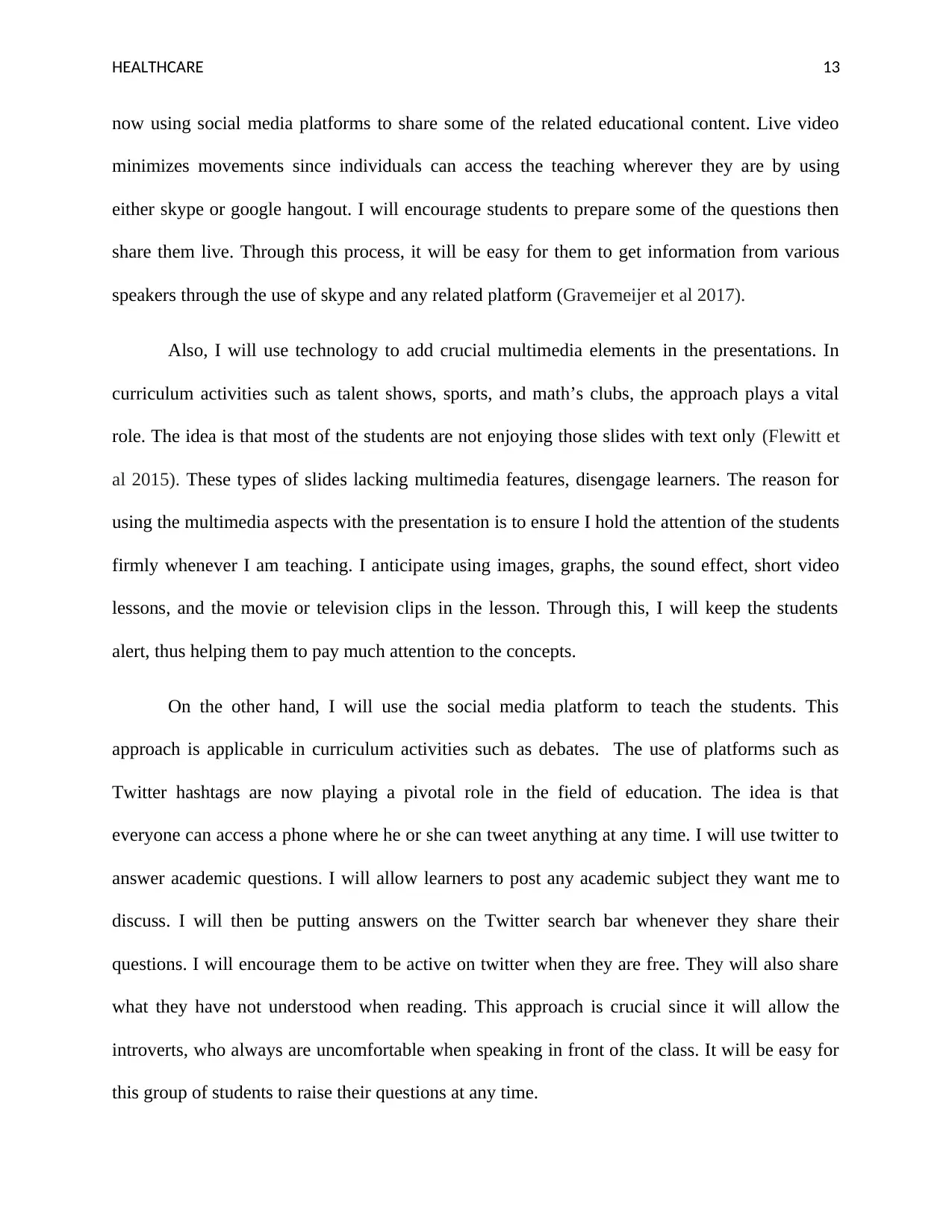
HEALTHCARE 13
now using social media platforms to share some of the related educational content. Live video
minimizes movements since individuals can access the teaching wherever they are by using
either skype or google hangout. I will encourage students to prepare some of the questions then
share them live. Through this process, it will be easy for them to get information from various
speakers through the use of skype and any related platform (Gravemeijer et al 2017).
Also, I will use technology to add crucial multimedia elements in the presentations. In
curriculum activities such as talent shows, sports, and math’s clubs, the approach plays a vital
role. The idea is that most of the students are not enjoying those slides with text only (Flewitt et
al 2015). These types of slides lacking multimedia features, disengage learners. The reason for
using the multimedia aspects with the presentation is to ensure I hold the attention of the students
firmly whenever I am teaching. I anticipate using images, graphs, the sound effect, short video
lessons, and the movie or television clips in the lesson. Through this, I will keep the students
alert, thus helping them to pay much attention to the concepts.
On the other hand, I will use the social media platform to teach the students. This
approach is applicable in curriculum activities such as debates. The use of platforms such as
Twitter hashtags are now playing a pivotal role in the field of education. The idea is that
everyone can access a phone where he or she can tweet anything at any time. I will use twitter to
answer academic questions. I will allow learners to post any academic subject they want me to
discuss. I will then be putting answers on the Twitter search bar whenever they share their
questions. I will encourage them to be active on twitter when they are free. They will also share
what they have not understood when reading. This approach is crucial since it will allow the
introverts, who always are uncomfortable when speaking in front of the class. It will be easy for
this group of students to raise their questions at any time.
now using social media platforms to share some of the related educational content. Live video
minimizes movements since individuals can access the teaching wherever they are by using
either skype or google hangout. I will encourage students to prepare some of the questions then
share them live. Through this process, it will be easy for them to get information from various
speakers through the use of skype and any related platform (Gravemeijer et al 2017).
Also, I will use technology to add crucial multimedia elements in the presentations. In
curriculum activities such as talent shows, sports, and math’s clubs, the approach plays a vital
role. The idea is that most of the students are not enjoying those slides with text only (Flewitt et
al 2015). These types of slides lacking multimedia features, disengage learners. The reason for
using the multimedia aspects with the presentation is to ensure I hold the attention of the students
firmly whenever I am teaching. I anticipate using images, graphs, the sound effect, short video
lessons, and the movie or television clips in the lesson. Through this, I will keep the students
alert, thus helping them to pay much attention to the concepts.
On the other hand, I will use the social media platform to teach the students. This
approach is applicable in curriculum activities such as debates. The use of platforms such as
Twitter hashtags are now playing a pivotal role in the field of education. The idea is that
everyone can access a phone where he or she can tweet anything at any time. I will use twitter to
answer academic questions. I will allow learners to post any academic subject they want me to
discuss. I will then be putting answers on the Twitter search bar whenever they share their
questions. I will encourage them to be active on twitter when they are free. They will also share
what they have not understood when reading. This approach is crucial since it will allow the
introverts, who always are uncomfortable when speaking in front of the class. It will be easy for
this group of students to raise their questions at any time.
Paraphrase This Document
Need a fresh take? Get an instant paraphrase of this document with our AI Paraphraser
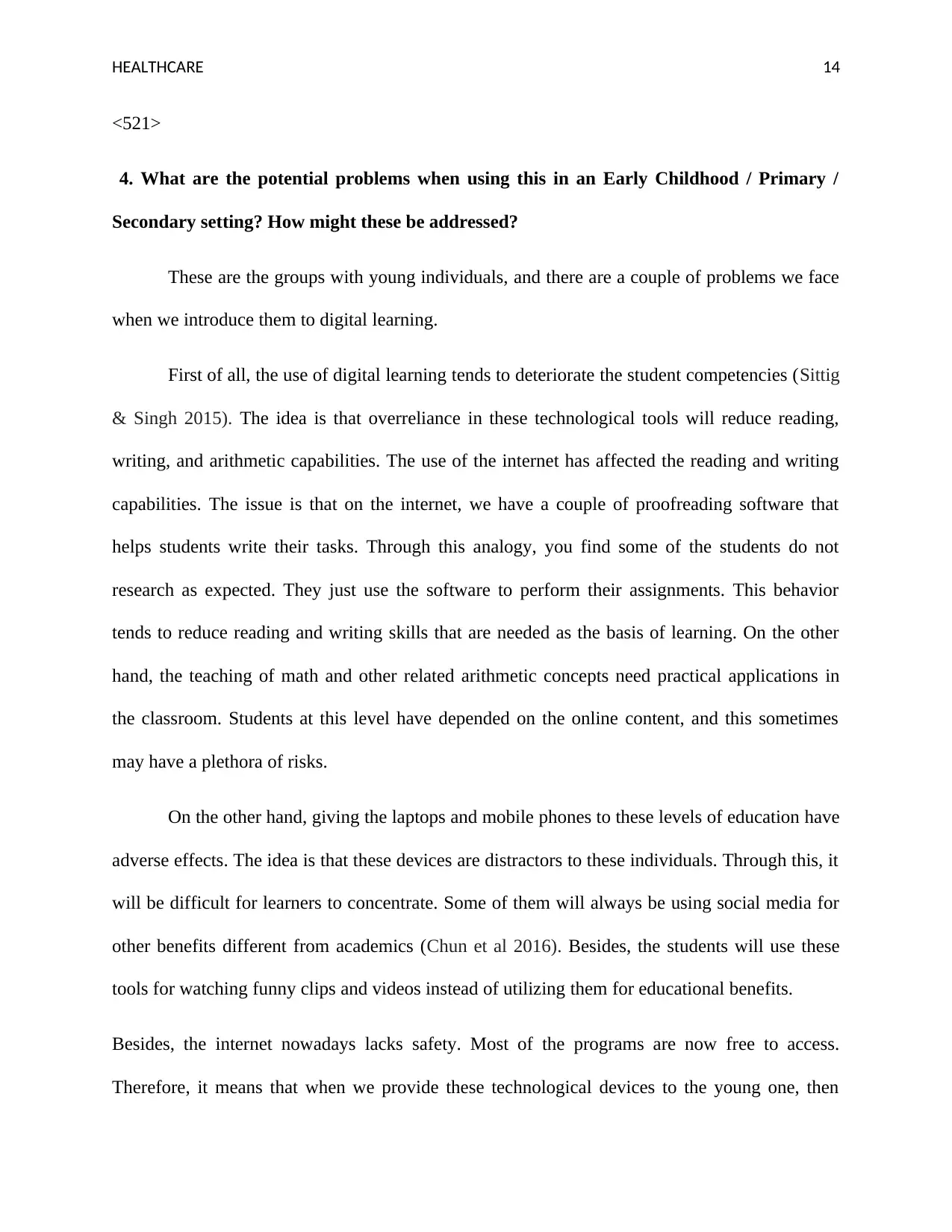
HEALTHCARE 14
<521>
4. What are the potential problems when using this in an Early Childhood / Primary /
Secondary setting? How might these be addressed?
These are the groups with young individuals, and there are a couple of problems we face
when we introduce them to digital learning.
First of all, the use of digital learning tends to deteriorate the student competencies (Sittig
& Singh 2015). The idea is that overreliance in these technological tools will reduce reading,
writing, and arithmetic capabilities. The use of the internet has affected the reading and writing
capabilities. The issue is that on the internet, we have a couple of proofreading software that
helps students write their tasks. Through this analogy, you find some of the students do not
research as expected. They just use the software to perform their assignments. This behavior
tends to reduce reading and writing skills that are needed as the basis of learning. On the other
hand, the teaching of math and other related arithmetic concepts need practical applications in
the classroom. Students at this level have depended on the online content, and this sometimes
may have a plethora of risks.
On the other hand, giving the laptops and mobile phones to these levels of education have
adverse effects. The idea is that these devices are distractors to these individuals. Through this, it
will be difficult for learners to concentrate. Some of them will always be using social media for
other benefits different from academics (Chun et al 2016). Besides, the students will use these
tools for watching funny clips and videos instead of utilizing them for educational benefits.
Besides, the internet nowadays lacks safety. Most of the programs are now free to access.
Therefore, it means that when we provide these technological devices to the young one, then
<521>
4. What are the potential problems when using this in an Early Childhood / Primary /
Secondary setting? How might these be addressed?
These are the groups with young individuals, and there are a couple of problems we face
when we introduce them to digital learning.
First of all, the use of digital learning tends to deteriorate the student competencies (Sittig
& Singh 2015). The idea is that overreliance in these technological tools will reduce reading,
writing, and arithmetic capabilities. The use of the internet has affected the reading and writing
capabilities. The issue is that on the internet, we have a couple of proofreading software that
helps students write their tasks. Through this analogy, you find some of the students do not
research as expected. They just use the software to perform their assignments. This behavior
tends to reduce reading and writing skills that are needed as the basis of learning. On the other
hand, the teaching of math and other related arithmetic concepts need practical applications in
the classroom. Students at this level have depended on the online content, and this sometimes
may have a plethora of risks.
On the other hand, giving the laptops and mobile phones to these levels of education have
adverse effects. The idea is that these devices are distractors to these individuals. Through this, it
will be difficult for learners to concentrate. Some of them will always be using social media for
other benefits different from academics (Chun et al 2016). Besides, the students will use these
tools for watching funny clips and videos instead of utilizing them for educational benefits.
Besides, the internet nowadays lacks safety. Most of the programs are now free to access.
Therefore, it means that when we provide these technological devices to the young one, then
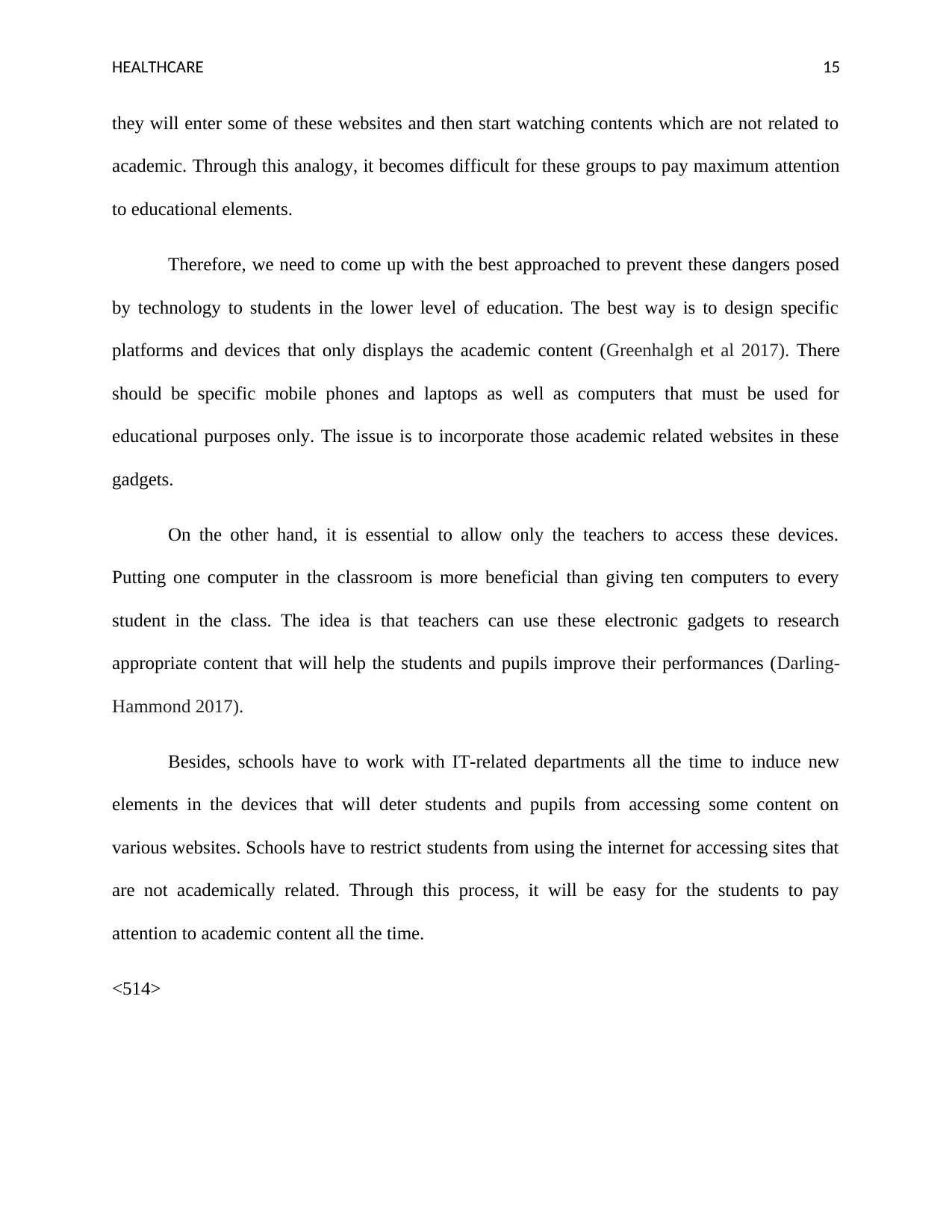
HEALTHCARE 15
they will enter some of these websites and then start watching contents which are not related to
academic. Through this analogy, it becomes difficult for these groups to pay maximum attention
to educational elements.
Therefore, we need to come up with the best approached to prevent these dangers posed
by technology to students in the lower level of education. The best way is to design specific
platforms and devices that only displays the academic content (Greenhalgh et al 2017). There
should be specific mobile phones and laptops as well as computers that must be used for
educational purposes only. The issue is to incorporate those academic related websites in these
gadgets.
On the other hand, it is essential to allow only the teachers to access these devices.
Putting one computer in the classroom is more beneficial than giving ten computers to every
student in the class. The idea is that teachers can use these electronic gadgets to research
appropriate content that will help the students and pupils improve their performances (Darling-
Hammond 2017).
Besides, schools have to work with IT-related departments all the time to induce new
elements in the devices that will deter students and pupils from accessing some content on
various websites. Schools have to restrict students from using the internet for accessing sites that
are not academically related. Through this process, it will be easy for the students to pay
attention to academic content all the time.
<514>
they will enter some of these websites and then start watching contents which are not related to
academic. Through this analogy, it becomes difficult for these groups to pay maximum attention
to educational elements.
Therefore, we need to come up with the best approached to prevent these dangers posed
by technology to students in the lower level of education. The best way is to design specific
platforms and devices that only displays the academic content (Greenhalgh et al 2017). There
should be specific mobile phones and laptops as well as computers that must be used for
educational purposes only. The issue is to incorporate those academic related websites in these
gadgets.
On the other hand, it is essential to allow only the teachers to access these devices.
Putting one computer in the classroom is more beneficial than giving ten computers to every
student in the class. The idea is that teachers can use these electronic gadgets to research
appropriate content that will help the students and pupils improve their performances (Darling-
Hammond 2017).
Besides, schools have to work with IT-related departments all the time to induce new
elements in the devices that will deter students and pupils from accessing some content on
various websites. Schools have to restrict students from using the internet for accessing sites that
are not academically related. Through this process, it will be easy for the students to pay
attention to academic content all the time.
<514>
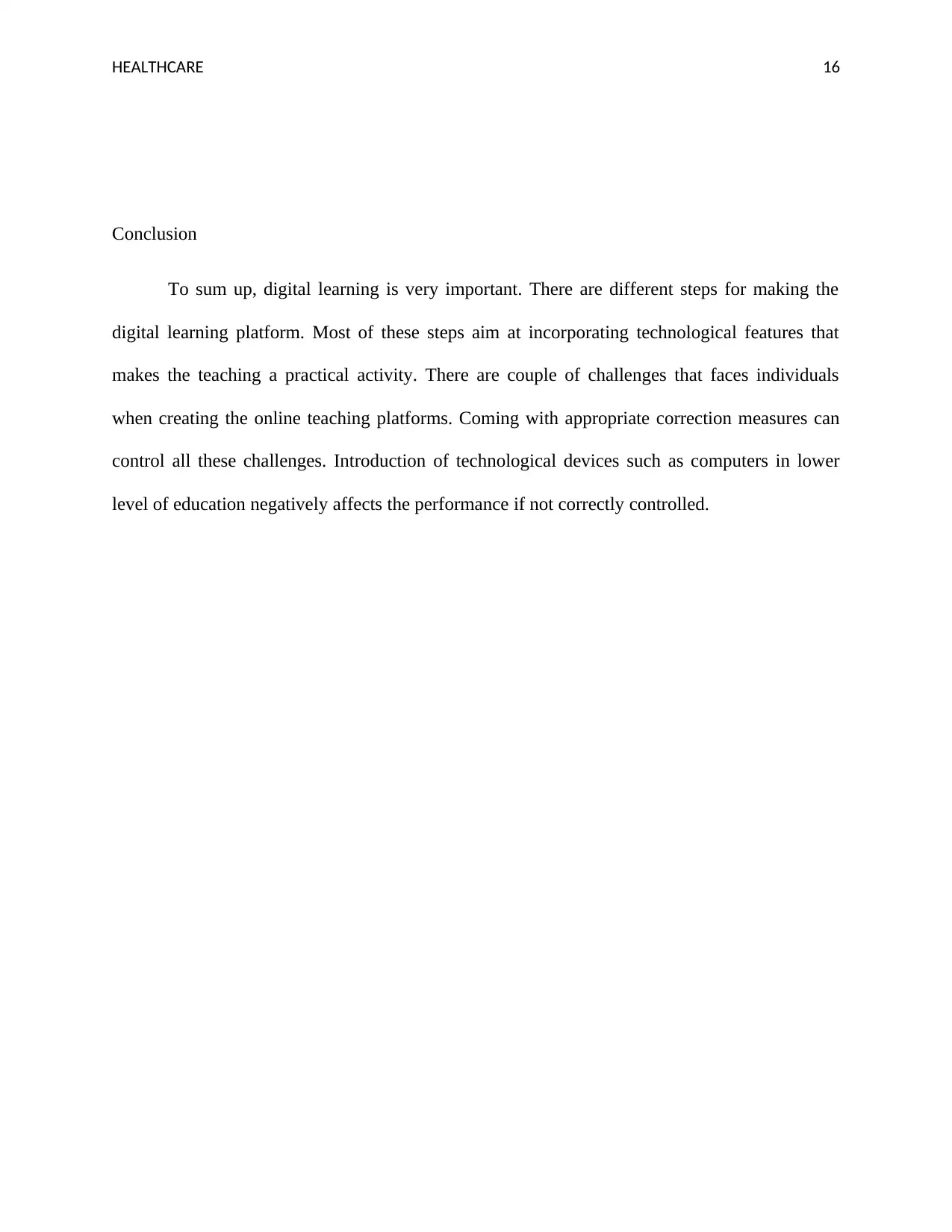
HEALTHCARE 16
Conclusion
To sum up, digital learning is very important. There are different steps for making the
digital learning platform. Most of these steps aim at incorporating technological features that
makes the teaching a practical activity. There are couple of challenges that faces individuals
when creating the online teaching platforms. Coming with appropriate correction measures can
control all these challenges. Introduction of technological devices such as computers in lower
level of education negatively affects the performance if not correctly controlled.
Conclusion
To sum up, digital learning is very important. There are different steps for making the
digital learning platform. Most of these steps aim at incorporating technological features that
makes the teaching a practical activity. There are couple of challenges that faces individuals
when creating the online teaching platforms. Coming with appropriate correction measures can
control all these challenges. Introduction of technological devices such as computers in lower
level of education negatively affects the performance if not correctly controlled.
Secure Best Marks with AI Grader
Need help grading? Try our AI Grader for instant feedback on your assignments.
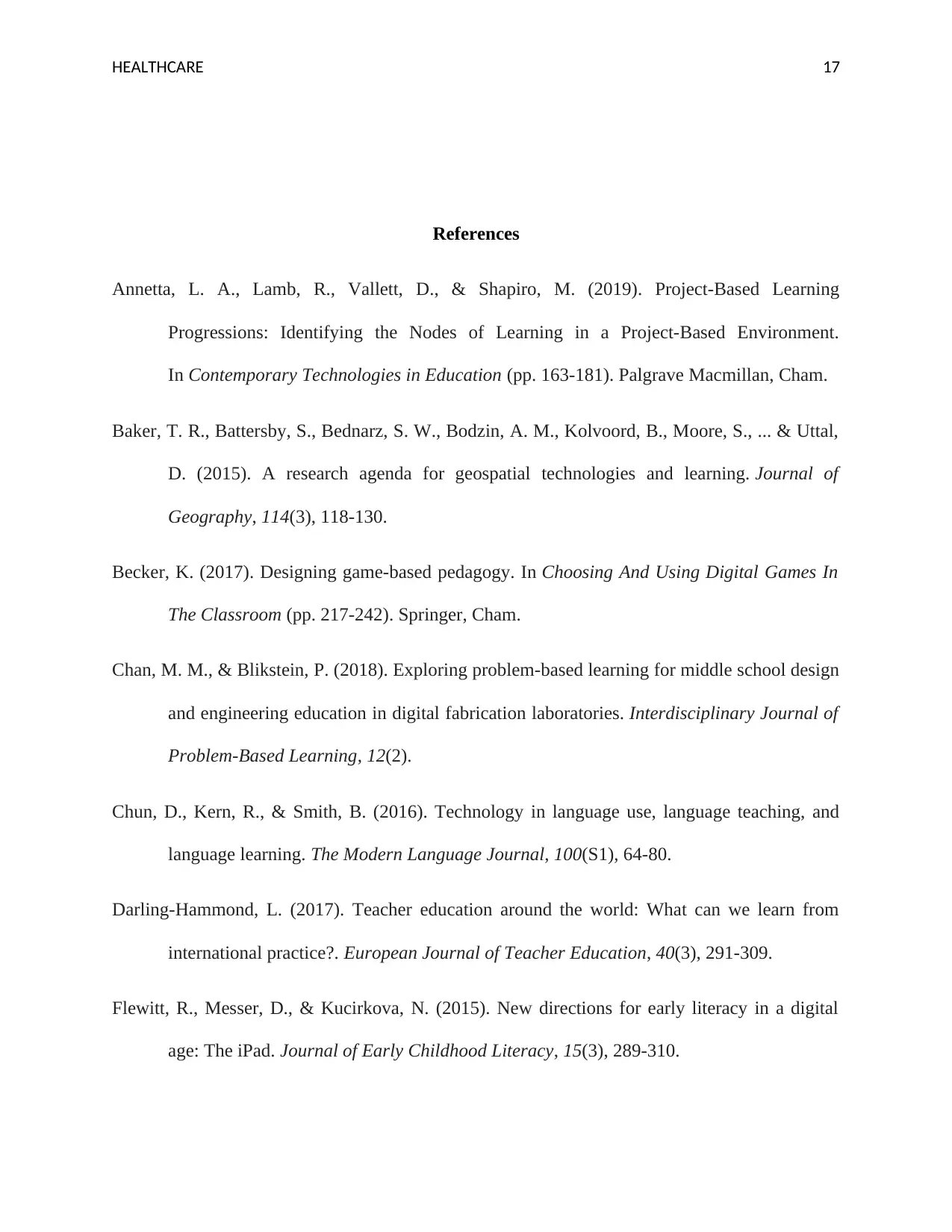
HEALTHCARE 17
References
Annetta, L. A., Lamb, R., Vallett, D., & Shapiro, M. (2019). Project-Based Learning
Progressions: Identifying the Nodes of Learning in a Project-Based Environment.
In Contemporary Technologies in Education (pp. 163-181). Palgrave Macmillan, Cham.
Baker, T. R., Battersby, S., Bednarz, S. W., Bodzin, A. M., Kolvoord, B., Moore, S., ... & Uttal,
D. (2015). A research agenda for geospatial technologies and learning. Journal of
Geography, 114(3), 118-130.
Becker, K. (2017). Designing game-based pedagogy. In Choosing And Using Digital Games In
The Classroom (pp. 217-242). Springer, Cham.
Chan, M. M., & Blikstein, P. (2018). Exploring problem-based learning for middle school design
and engineering education in digital fabrication laboratories. Interdisciplinary Journal of
Problem-Based Learning, 12(2).
Chun, D., Kern, R., & Smith, B. (2016). Technology in language use, language teaching, and
language learning. The Modern Language Journal, 100(S1), 64-80.
Darling-Hammond, L. (2017). Teacher education around the world: What can we learn from
international practice?. European Journal of Teacher Education, 40(3), 291-309.
Flewitt, R., Messer, D., & Kucirkova, N. (2015). New directions for early literacy in a digital
age: The iPad. Journal of Early Childhood Literacy, 15(3), 289-310.
References
Annetta, L. A., Lamb, R., Vallett, D., & Shapiro, M. (2019). Project-Based Learning
Progressions: Identifying the Nodes of Learning in a Project-Based Environment.
In Contemporary Technologies in Education (pp. 163-181). Palgrave Macmillan, Cham.
Baker, T. R., Battersby, S., Bednarz, S. W., Bodzin, A. M., Kolvoord, B., Moore, S., ... & Uttal,
D. (2015). A research agenda for geospatial technologies and learning. Journal of
Geography, 114(3), 118-130.
Becker, K. (2017). Designing game-based pedagogy. In Choosing And Using Digital Games In
The Classroom (pp. 217-242). Springer, Cham.
Chan, M. M., & Blikstein, P. (2018). Exploring problem-based learning for middle school design
and engineering education in digital fabrication laboratories. Interdisciplinary Journal of
Problem-Based Learning, 12(2).
Chun, D., Kern, R., & Smith, B. (2016). Technology in language use, language teaching, and
language learning. The Modern Language Journal, 100(S1), 64-80.
Darling-Hammond, L. (2017). Teacher education around the world: What can we learn from
international practice?. European Journal of Teacher Education, 40(3), 291-309.
Flewitt, R., Messer, D., & Kucirkova, N. (2015). New directions for early literacy in a digital
age: The iPad. Journal of Early Childhood Literacy, 15(3), 289-310.

HEALTHCARE 18
Gravemeijer, K., Stephan, M., Julie, C., Lin, F. L., & Ohtani, M. (2017). What mathematics
education may prepare students for the society of the future?. International Journal of
Science and Mathematics Education, 15(1), 105-123.
Greenhalgh, T., Wherton, J., Papoutsi, C., Lynch, J., Hughes, G., Hinder, S., ... & Shaw, S.
(2017). Beyond adoption: a new framework for theorizing and evaluating nonadoption,
abandonment, and challenges to the scale-up, spread, and sustainability of health and care
technologies. Journal of medical Internet research, 19(11), e367.
Kennedy, M. (2016). Parsing the practice of teaching. Journal of Teacher Education, 67(1), 6-
17.
Matuk, C. F., Linn, M. C., & Eylon, B. S. (2015). Technology to support teachers using evidence
from student work to customize technology-enhanced inquiry units. Instructional
Science, 43(2), 229-257.
Nagel, J. K., Ludwig, P., & Lewis, E. (2017, June). Community health innovation through an
interprofessional course. In 124th ASEE Annual Conference and Exposition, Columbus,
OH. Retrieved from https://peer. asee. org/28051.
Singh, H., & Miah, S. J. (2019). Design of a mobile-based learning management system for
incorporating employment demands: Case context of an Australian University. Education
and Information Technologies, 24(2), 995-1014.
Sittig, D. F., & Singh, H. (2015). A new socio-technical model for studying health information
technology in complex adaptive healthcare systems. In Cognitive informatics for
biomedicine (pp. 59-80). Springer, Cham.
Gravemeijer, K., Stephan, M., Julie, C., Lin, F. L., & Ohtani, M. (2017). What mathematics
education may prepare students for the society of the future?. International Journal of
Science and Mathematics Education, 15(1), 105-123.
Greenhalgh, T., Wherton, J., Papoutsi, C., Lynch, J., Hughes, G., Hinder, S., ... & Shaw, S.
(2017). Beyond adoption: a new framework for theorizing and evaluating nonadoption,
abandonment, and challenges to the scale-up, spread, and sustainability of health and care
technologies. Journal of medical Internet research, 19(11), e367.
Kennedy, M. (2016). Parsing the practice of teaching. Journal of Teacher Education, 67(1), 6-
17.
Matuk, C. F., Linn, M. C., & Eylon, B. S. (2015). Technology to support teachers using evidence
from student work to customize technology-enhanced inquiry units. Instructional
Science, 43(2), 229-257.
Nagel, J. K., Ludwig, P., & Lewis, E. (2017, June). Community health innovation through an
interprofessional course. In 124th ASEE Annual Conference and Exposition, Columbus,
OH. Retrieved from https://peer. asee. org/28051.
Singh, H., & Miah, S. J. (2019). Design of a mobile-based learning management system for
incorporating employment demands: Case context of an Australian University. Education
and Information Technologies, 24(2), 995-1014.
Sittig, D. F., & Singh, H. (2015). A new socio-technical model for studying health information
technology in complex adaptive healthcare systems. In Cognitive informatics for
biomedicine (pp. 59-80). Springer, Cham.
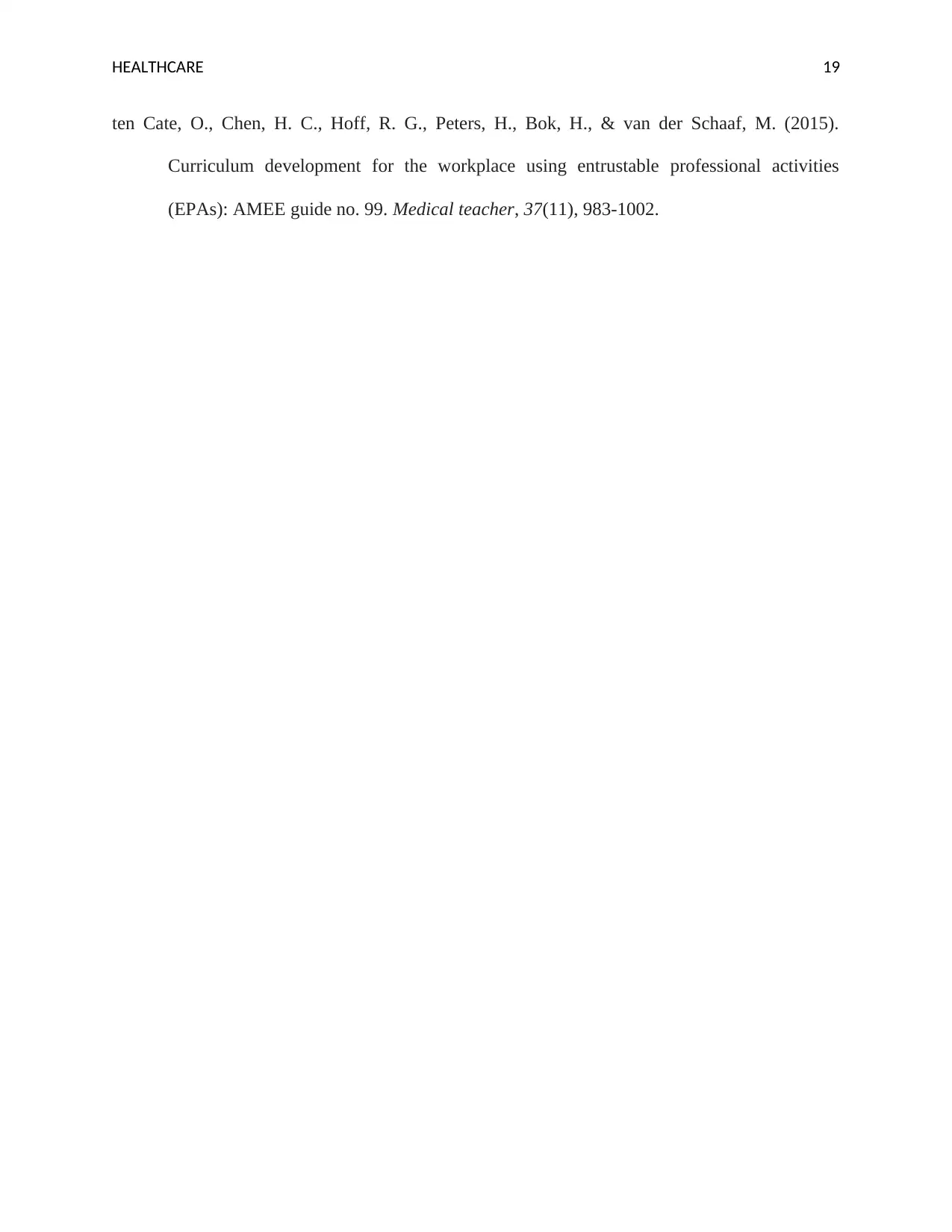
HEALTHCARE 19
ten Cate, O., Chen, H. C., Hoff, R. G., Peters, H., Bok, H., & van der Schaaf, M. (2015).
Curriculum development for the workplace using entrustable professional activities
(EPAs): AMEE guide no. 99. Medical teacher, 37(11), 983-1002.
ten Cate, O., Chen, H. C., Hoff, R. G., Peters, H., Bok, H., & van der Schaaf, M. (2015).
Curriculum development for the workplace using entrustable professional activities
(EPAs): AMEE guide no. 99. Medical teacher, 37(11), 983-1002.
1 out of 19
Related Documents
Your All-in-One AI-Powered Toolkit for Academic Success.
+13062052269
info@desklib.com
Available 24*7 on WhatsApp / Email
![[object Object]](/_next/static/media/star-bottom.7253800d.svg)
Unlock your academic potential
© 2024 | Zucol Services PVT LTD | All rights reserved.




